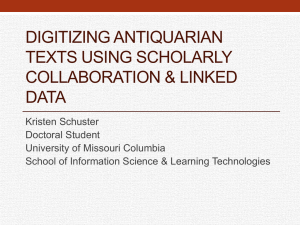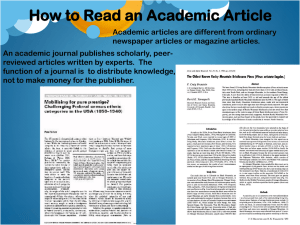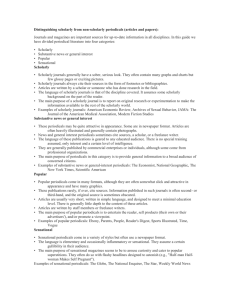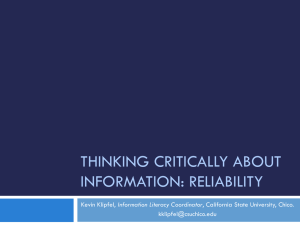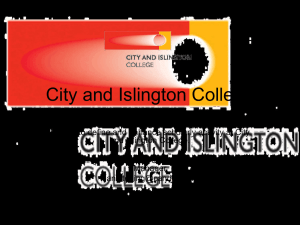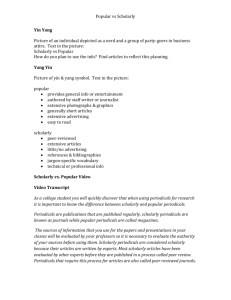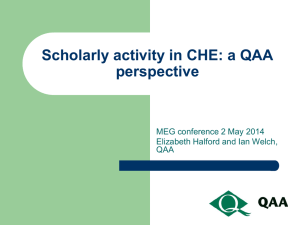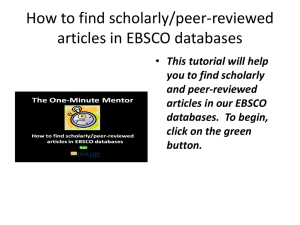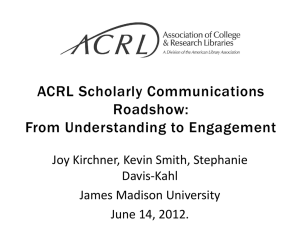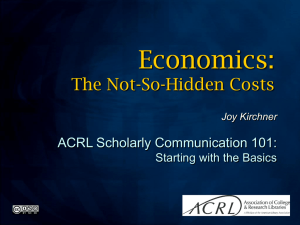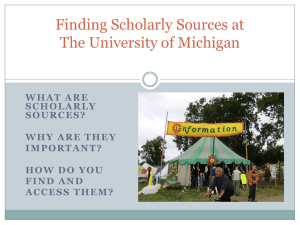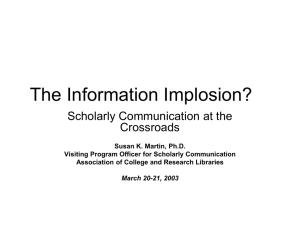Faculty Research Presentation
advertisement
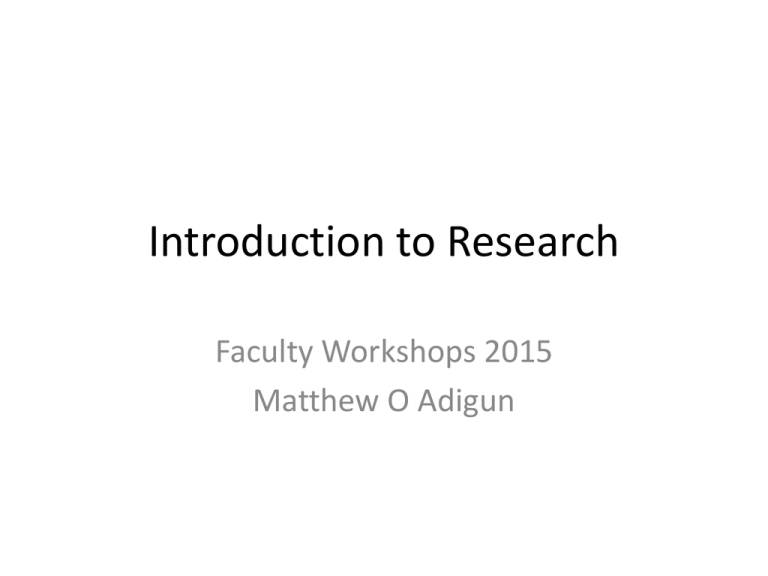
Introduction to Research Faculty Workshops 2015 Matthew O Adigun Research as a Sign of intelligence • Intelligence: ‘the adaptation of an environment to suit needs’, therefore humans are acknowledged as the most 'intelligent' of species. • Humans observe, identify, plan and then effect change. Humans have social gain through information as well as resource sharing. • The Human specie is distinguished by complex language structures and the written word to share information from one person to another. Literate societies with well structured, permanent means of communicating information have immense evolutionary advantage. We Research every day • Humans are 'intuitive' scientists .... • always asking questions and • testing theories about themselves, others, events, the environment and • the world around them What is Research? • Research… is asking a question and finding out the answer..... • - looking into something. • - looking for something. • - comparing and contrasting things. • - finding out more information...it is counting things ...making enquiries...being curious...finding out what people think...finding out what people do....finding out what works.... finding out what doesn't work...finding out what people want... What research have you conducted recently? • What decisions have you made about your day? • What decisions have you made today? • What influenced your decision to take this course? • How do you prepare and write assignments? • How do you decide how to provide the best quality of service for your service users? What do we research? • We research people and their behaviour, opinions, attitudes, trends and patterns, also politics, animals, health and illness. Research can be conducted either informally for our own benefit, through asking questions, watching, counting or reading and formally, for medical or academic purposes, as a marketing strategy, to inform and influence politics and policy. • Research may be carried out in our own lives, through the media, in our place of work, with our friends and family or through reading past research. • Our views - personal, social, community and worldwide and our own identities are socially constructed through our own theorising. What does research tell us? • Research gives us information about: – Thoughts and opinions – Attitudes – Habits – Culture – Norms – Scientific facts – Medical information What do we do with research? • • • • • • Have it as interesting fact Use it to make decisions Use it to persuade influence others Use it to affect change Use it to change behaviour Use it to better use...medical ...improve customer care...write better funding applications....monitor and evaluate our provision.... In a nutshell…. • We research in order to – understand society and social processes, – as well as to test and or create theories – in order that we are better able to inform about social action and potentially 'improve' social conditions. Knowledge, Interpretation and dissemination • Gathering data from direct and indirect sources: – – – – – observations questionnaires interviews experiments other research • Processing data for interpretation numerically and or verbally: – statistics – themes or perspectives Dissemination of findings • • • • written reports presentations seminars supply to media When we conduct research, It should be… • • • • Systematic Non-discriminatory Open to criticism Independent and free from and direct and or indirect censorship Research Theory • Research is approached in a variety of ways...in its methods, analysis and presentation...which may be influenced by the theoretical approach the researcher takes. • The appendix of "Research theory" offers a brief introduction to some of the theoretical positions as well as some links which you can use to research further. In Closing….. • All academic subjects require research to reach conclusions and establish theories, or simply to find out more about a particular situation or phenomenon. • You will need to learn more about research methods and data in both an academic context, for when you are researching for your Degree as well as a professional context in order to give you a better understanding of the role and uses of research within the voluntary and community sector. Orientation to Knowledge Production (How Information is Created and Organized) Faculty Workshops 2015 Knowledge Production (Scientific Experimentation or Research in a Library) • Somebody thinks of an idea (researcher and his team) • Decide to pursue the idea further (funding proposals/applications ) • Ready to invest time and money to germinate the idea (find a funder on short or long term basis) • This process can take years and cost a lot of money (multiple funders with varying interests) Resources needed to Produce new Knowledge • Large Institutions ONLY can provide such resources. • Universities • Government Agencies: ARC, MRC, NRF, CSIR etc. • Large NGOs • Large Corporations • Partnerships can be key to new knowledge production. E.g. Richards Bay IDZ + Unizulu Information Produced by Government • Elected officials need info about Society in order to make economic, social and political policy decisions. • Therefore, agencies at federal, state and local government levels are tasked with conducting research using Tax Rand. • Obligation to provide citizen access to Information at little or no additional cost. • Federal Depository Libraries/ the Internet is now significant mechanism for doing this. Information Produced in Academic Institutions • Academic in Sciences, Humanities, Social Sciences produce new scholarly knowledge; • Scholarly research produces results that can be used to solve practical and social problems. • Scholarly Knowledge is published in Books and Scholarly journals. • Can locate this knowledge by searching library catalogs and scholarly journal indexes; To be published in a scholarly journal or Book • Researchers submit their findings to a publication's peer review board; • Faculty researchers try to match the content and style of their research to a particular journal's focus and audience; • Evaluated by a panel of experts in the field for the merit of its ideas, originality, thoroughness in research, accuracy, and contribution to the body of knowledge in the discipline. Acceptance or Rejection stage • The peer review board then makes a recommendation to accept or reject the work for publication. • Accept implies one of two options: • Often the peer review board makes suggestions for revisions or • further clarification that may require rewriting and additional research Larger Purpose of Knowledge Production • The publication of an article or book encourages other scholars to further explore the research to corroborate or dispute it. • This exchange and debate of ideas and findings contributes to the production of the larger body of knowledge within a discipline. • Note: It is very rare in today’s ‘cheap’ dissertation and thesis to see corroborating or disputing contributions. Knowledge Searching needs to be learned • The way academic disciplines structure knowledge affects searching. • If you wish to effectively locate information you must have some idea of how academic disciplines and libraries structure knowledge. • This skill will also be handy if your research requires you to re-arrange existing knowledge when answering your research question or testing an hypothesis. Information Produced in the Private Sector (Non-governmental sources of information) • • • • • Commercial newspapers, magazine and book publishers, the film and television industry, corporate laboratories, business research firms, associations, advocacy groups, and think tanks, • all gather data and produce information. Forms of Private Sector Knowledge • • • • • • • • magazines, books, bulletins, conferences, pamphlets, videos, technical reports, and company annual reports etc. Purpose for Private Sector Knowledge • For internal use within the organization and may not be available to the general public. • Companies and laboratories often patent or trademark information that is the result of their research. • Patents and trademarks give the holder of the patent or trademark exclusive rights to the information. Note of Warning: Don’t use Private Sector Information anyhow • When using any publication, it is important to know as much as possible about the organization, its goals and motives, and its reputation. • Points of view, as well as goals and motives, are reflected in the information organizations produce. • You might be endorsing an organisation’s ideology or contaminated reputation without knowing it. Politics of Private Sector or Corporate World • Business publication--primarily concerned with the research, development and promotion of a product--differ from that of a consumer advocacy group; • Even advocacy groups or organizations which are formed around particular issues, political or social agendas, have differing and conflicting perspectives of the same issue; • A good researcher will avoid pitching their tent with conflicting perspectives. Forms of Packaging Information • Periodicals, newspapers, films, television, and radio all have different audiences and are accessible to different people in different ways. • Most serious scholarly research is published in books and journals because these forms of publication have been defined by our culture as appropriate for scholarly communication. • Occasionally serious research will be presented in the format of a documentary film, but usually the film medium is reserved for entertainment in ‘American’ society. Vital Information about a Book • A Scholarly Book is either A Fiction or non-fiction • Works of fiction contain material that is not true to life even though the events reported may be based on the real life experience of the author. • Characters and scenes are invented by the author to tell a story. • Novels, short stories, and poems are examples of fiction. Organisation of Non-Fiction Scholarly Books • Non-fiction books deal with more factual information. • All reference books, history, literary criticism, and science books are classed as non-fiction. • A non-fiction Book consists of a Title Page, a Table of Content plus preliminary materials and the main Body of the Book. • The back of a Scholarly book consists of Glossary, Appendices, Bibliography and or index. Main Body of a Scholarly Book • The main body of the book is generally divided into chapters. • Each chapter may identify the sources used in the form of footnotes (at the bottoms of the pages), or endnotes (and the end of each chapter). • In many books, the notes appear at the back of the book. • Scanning footnotes and endnotes is a productive and efficient way to find additional sources for your research Back of a Scholarly Book • glossary--a list with definitions of unfamiliar terms used in the text • appendices--supplemental materials, charts, tables, maps, statistics • bibliography--a list of all the books, articles, and other resources the author used in writing the book. • Scanning the bibliography is one of the best ways to find additional high quality sources for your research. • Index--an alphabetical list of terms, subjects, names discussed in the book to aid in locating information within the text of the work. What is a Periodical? • The word periodical means ‘published at regular intervals’. Specific examples of periodicals include popular magazines, scholarly journals, industry and TRADE magazines, newsletters, newspapers and e-zines. • When doing research, it is important to be able to distinguish between the various types of periodicals--especially between popular magazines and scholarly journals. • The type(s) of periodicals you use for a project depends on the focus and purpose of your research. How Do You Select Appropriate Periodical? • As a rule, you should be using scholarly journals in your projects. • Yet, there are instances in which it is appropriate and necessary to use popular magazines, TRADE and industry journals, and newspapers. • How can you tell the difference? Here is a printable chart listing the features of different types of periodicals. Popular Magazine • • • • • Articles written with the general public in mind Current events, hot topics, social and political commentary Written in non-technical, easy-to-understand language Articles edited or reviewed by employees of the magazine Author is a journalist, freelance writer, layperson, or not listed at all • Few or no references or notes • Published weekly, or monthly • Glossy appearance, many photographs, many advertisements Scholarly Journals • Articles written primarily with other scholars in mind • Complex writing, specialized language of the discipline • Articles reviewed and edited by other scholars in the field • Author is an expert in field of study • Many footnotes, lengthy bibliography • Serious appearance, few if any advertisements • Title contains words like: Journal of, Review, Quarterly Finally…. • Research should be about applying our intelligence: adapt your environment to suit needs; • Our students should learn to ask interesting questions. ‘How’ is good if you are looking into; ‘what’ is better if you are looking for something; but ‘why’ is the winner if you want to explain a mystery or tackle complex problems. • Only lazy researcher ask ‘Can’ questions. Research is meant to be published.. • Otherwise, why do research? • Contributions should endeavour to corroborate or dispute existing knowledge. • Finally, rigour is the ONLY PROOF that your contributions are not cheap political campaigns. • Thanks for LISTENING!!!!!
